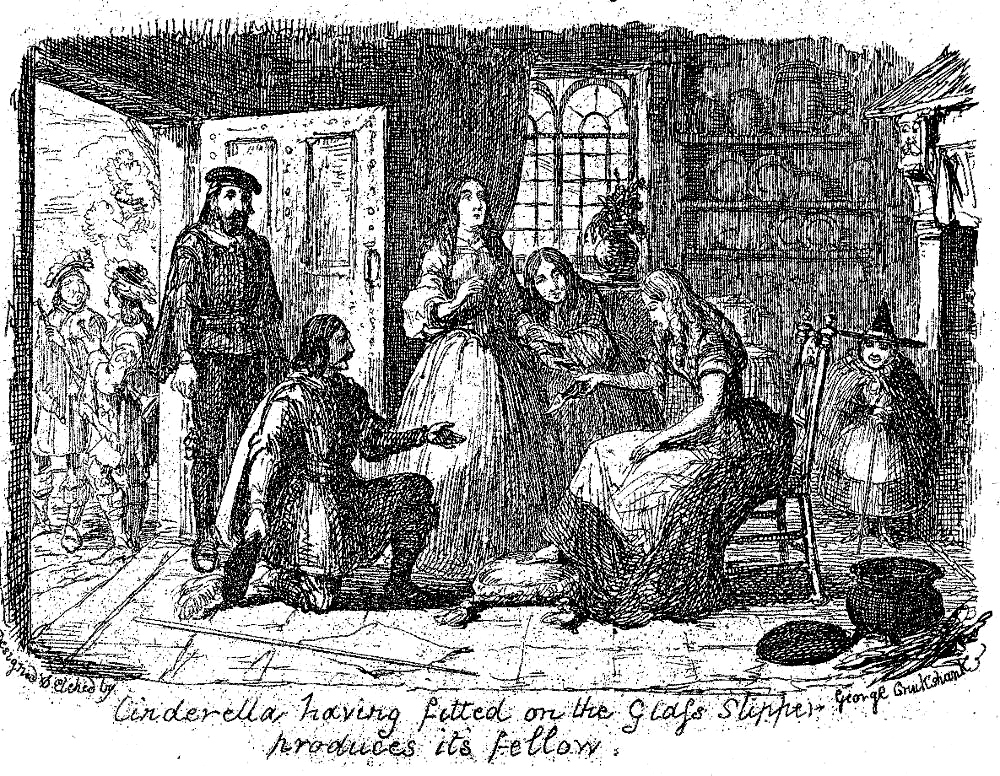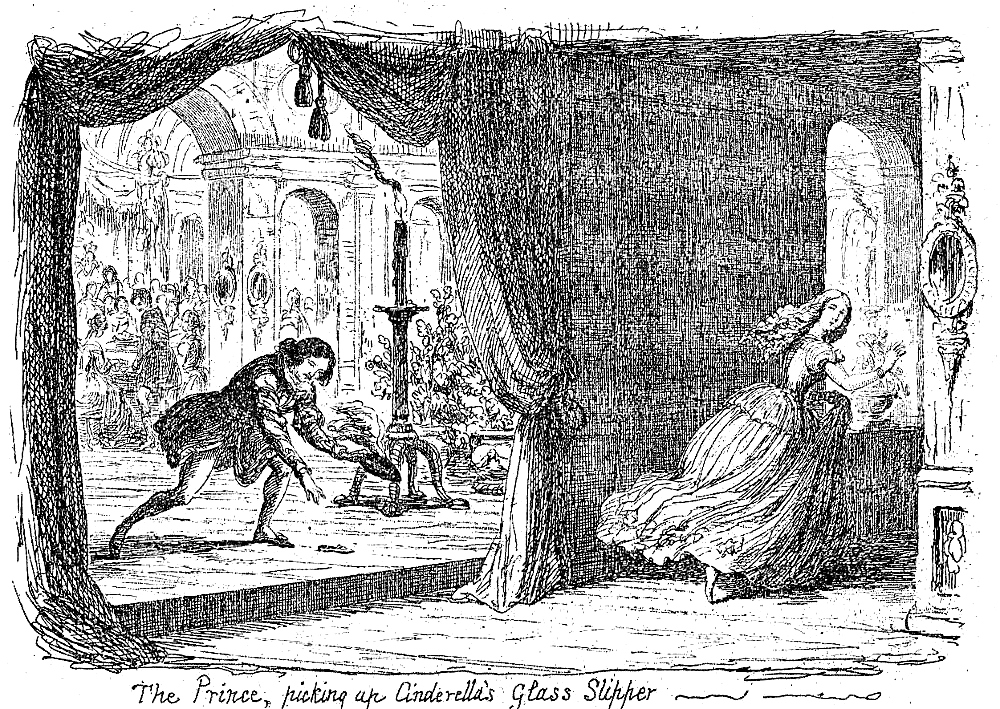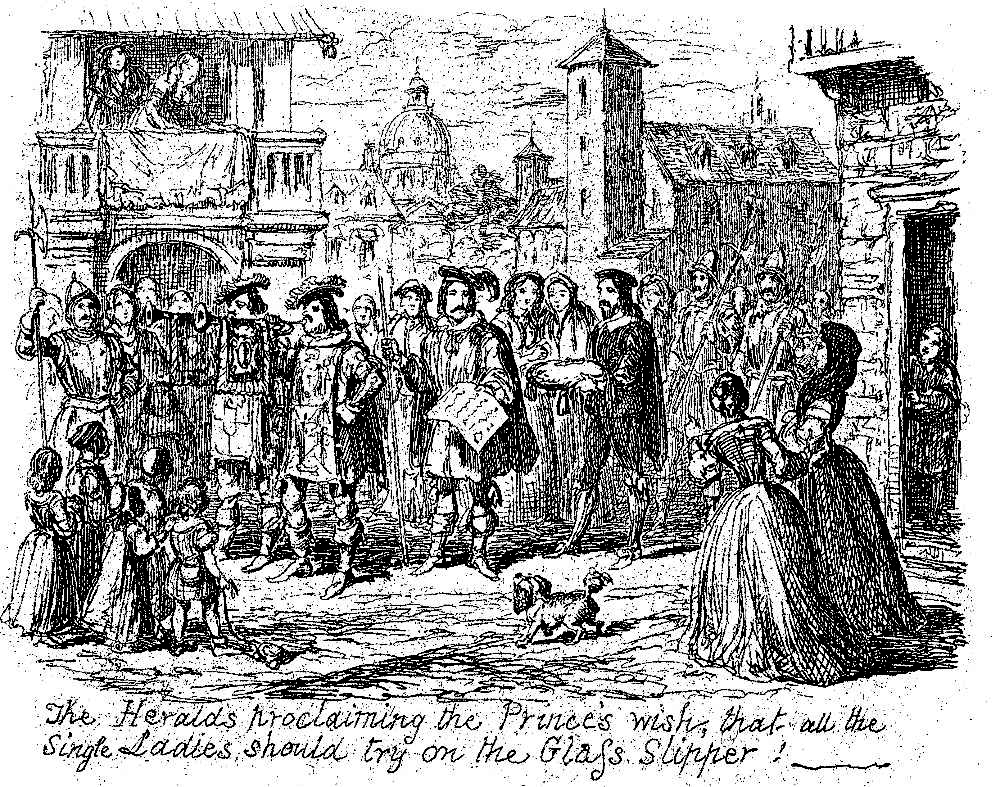
Cinderella having fitted on the Glass Slipper produces its Fellow (6.5 cm high by 9.7 cm wide, vignetted, facing page 20) — the ninth illustration for both the single-volume edition of 1854 and for the third tale in the 1865 anthology, George Cruikshank's Fairy Library. The King's heralds having arrived in the vicinity of Cinderella's home, they enter the kitchen to try to slipper on the step-sisters before noticing Cinderella. In the previous frame, the Chamberlain is about to read the proclamation after the Heralds have sounded their trumpets. Now, however, we return to the domestic sphere. Complementing Cruikshank's textual description, the full-page picture of the wedding will logically follow the half-page illustration of the royal Chamberlain's fitting the glass slipper on Cinderella's foot in the kitchen, where so much of the early action occurred. The "dwarf" or Fairy God-mother whose machinations have produced this highly satisfactory result watches the proceedings from the side as the sisters respond in amazement. This is the fourth and final kitchen scene.
Scanned image and text by Philip V. Allingham. [You may use this image without prior permission for any scholarly or educational purpose as long as you (1) credit the person who scanned the image and (2) link your document to this URL.]
The illustrations appearing here are from the collection of the commentator.
Passage Illustrated
The Chamberlain and attendants had gone nearly all over the town, and were growing weary, when they turned to where Cinderella lived, which was a little out of the road. The sisters were standing at the kitchen door, the mother at her bedroom window, for she was still unable to leave her room, and poor Cinderella in her dingy dress was peeping over her sisters' shoulders. The chamberlain came forward, requesting the to try on the slipper, — which they did to their uttermost, at the same time feeling that it was of very little use ; after several unsuccessful efforts, they gave back the slipper, but the Chamberlain, having caught sight of Cinderella sitting in her old corner, requested that she also would try on the glass slipper; but the sisters set up a loud laugh, and said the idea was ridiculous! and would not allow any such thing; but the Chamberlain said his orders were imperative that all should try it on, — besides which, although it was a dark corner where Cinderella was, he saw enough to convince him that those beautiful long ringlets belonged to a beautiful face and person. He then requested Cinderella to take a seat. Just before this the dwarf had come in, and had privately handed the other glass slipper to Cinderella, which she had put into her pocket. However, she now stepped forward, took her seat, placed her foot upon the cushion, and the slipper slipped on in an instant, with the greatest ease. The sisters could scarcely believe their eyes; the Chamberlain and the attendants were surprised and startled ; but they were all much more so when Cinderella quietly drew forth from her pocket the fellow glass slipper. — "Cinderella and The Glass Slipper," pp. 20-21.
The Context in Perrault
What they said was very true; for a few days later, the king's son had it proclaimed, by sound of trumpet, that he would marry her whose foot this slipper would just fit. They began to try it on the princesses, then the duchesses and all the court, but in vain; it was brought to the two sisters, who did all they possibly could to force their foot into the slipper, but they did not succeed.
Cinderella, who saw all this, and knew that it was her slipper, said to them, laughing, "Let me see if it will not fit me."
Her sisters burst out laughing, and began to banter with her. The gentleman who was sent to try the slipper looked earnestly at Cinderella, and, finding her very handsome, said that it was only just that she should try as well, and that he had orders to let everyone try.
He had Cinderella sit down, and, putting the slipper to her foot, he found that it went on very easily, fitting her as if it had been made of wax. Her two sisters were greatly astonished, but then even more so, when Cinderella pulled out of her pocket the other slipper, and put it on her other foot. Then in came her godmother and touched her wand to Cinderella's clothes, making them richer and more magnificent than any of those she had worn before.
And now her two sisters found her to be that fine, beautiful lady whom they had seen at the ball. They threw themselves at her feet to beg pardon for all the ill treatment they had made her undergo. Cinderella took them up, and, as she embraced them, said that she forgave them with all her heart, and wanted them always to love her. — Chales Perrault, "Cinderella; or, The Little Glass Slipper."
Commentary
After the former illustration, The Prince, picking up Cinderella's Glass Slipper, the logical consequence or next step in the narrative chain of events is the Prince's attempting to find the owner of the glass slipper. Cinderella has lost one of her glass slippers as she panics about the lateness of the hour on the night of the second ball, in Cinderella, leaving the Royal Palace after the Clock had Struck Twelve!. Unlike the Seven-league Boots in "Hop-o' My-Thumb," the magic slipper is not elastic: it fits only Cinderella, and therefore sets her apart from all the other marriageable maidens in the kingdom. Since that loss, the pair are incomplete — like the Prince and Cinderella, so that the successful matching of slipper and owner in the present frame, Cinderella having fitted on the Glass Slipper produces its Fellow (bottom of tipped-in illustration, facing page 20), is the climax of the story, — and the moment that serves as a metonymy for the entire rags-to-riches trajectory of a story that must have been very popular among the lower and middle classes as a folktale long before it became a text to be consumed by the literate classes. In The Dickens Index, Bentley et al. note that Dickens's focus in his allusions to the story is the glass slipper:
Cinderella's slipper, the slipper (fur in Perrault's version of the story, glass in the English version) left behind when Cinderella flees from the ball before midnight should strike, and she be changed back into her rags. The love-struck Prince searches through all the realm to find the foot that will fit the slipper, eventually discovering the rightful owner despite obstruction from her Ugly Sisters. — Bentley et al., p. 55.
Dickens specifically alludes to the glass slipper in Dombey and Son, Chapter 6, "Paul's Second Deprivation," when the witch-like Mrs. Brown, an "anti-Fairy Godmother" like Fagin in Oliver Twist, has stripped Florence of her costly clothing and dressed her in rags, and then cast her adrift in "The Great Oven." Miraculously, Florence finds her way to the Dombey wharf, where the kindly manager entrusts her to Walter Gay of her father's business:
Mr. Clark stood rapt in amazement: observing under his breath, I never saw such a start on this wharf before. Walter picked up the shoe, and put it on the little foot as the Prince in the story might have fitted Cinderella’s slipper on. He hung the rabbit-skin over his left arm; gave the right to Florence; and felt, not to say like Richard Whittington — that is a tame comparison — but like Saint George of England, with the dragon lying dead before him.
"Don't cry, Miss Dombey," said Walter, in a transport of enthusiasm. "What a wonderful thing for me that I am here! You are as safe now as if you were guarded by a whole boat's crew of picked men from a man-of-war. Oh, don't cry." — Dombey and Son, pp. 39-40.
Walter Gay, in other words, restores her name and identity to the victimized Florence, as if he were the Prince discovering his bride in the scullery girl. Dickens also alludes to the glass slipper from "Cinderella" in Little Dorrit, Book One, Chapter 2 ("Fellow Travellers"), when the practical but warm-hearted man of business Mr. Meagles recounts how he came to adopt the fancifully-nicknamed Tattycoram:
"So I said next day: Now, Mother, I have a proposition to make that I think you'll approve of. Let us take one of those same little children to be a little maid to Pet. We are practical people. So if we should find her temper a little defective, or any of her ways a little wide of ours, we shall know what we have to take into account. We shall know what an immense deduction must be made from all the influences and experiences that have formed us — no parents, no child-brother or sister, no individuality of home, no Glass Slipper, or Fairy Godmother. And that's the way we came by Tattycoram." — p. 10.
In the Cruikshank illustration, the presences of the Prince and the Fairy-Godmother are only implied, as the Prince's agent, the Chamberlain, expresses amazement that the slipper fits perfectly. Outside, the two trumpeters seen in the previous frame now lounge in the sun, awaiting the outcome of this private fitting. Thus, the two chief social milieus of the narrative-pictorial sequence join as the earlier kitchen scenes, suggestive of Cinderella's domestic servitude, blend with the privileged world of the court, glimpsed briefly in the backdrop of The Prince, picking up Cinderella's Glass Slipper (facing page 19). The stout, studded door of the kitchen (left) recalls Cinderella's desperate dash into the darkness in Cinderella, leaving the Royal Palace after the Clock had Struck Twelve! after the palace clock has warned her of her imminent reversion to the form of a scullery-wench. That the Royal Chamberlain kneels before the kitchen-girl signals her triumph (with the assistance of the diminutive figure behind her chair) over the pettiness of her family and her unfortunate circumstances generally. In the background are the settle, platters, leaded-pane window, and fireplace (with face in the capital of the supporting pillar), and flagstone floor seen previously in Cinderella scouring the Pots and Kettles (facing page 8) and The Pumpkin, and the Rat, and the Mice, and the Lizards (facing page 13). However, this vision of the kitchen is far less cluttered with objects and focuses on the cushion, centre, around which Cruikshank has posed the Prince's representatives, the Chamberlain and Herald (left — contrary to some conventions, the Prince himself in neither Perrault nor Cruikshank fits the slipper on Cinderella's foot), the taller and short step-sisters seen in three previous panels, and the enthroned heroine, with her advisor and mentor in front of the fireplace. Curiously, the key element in the Chamberlain's suspecting that the scullery-girl is, in fact, the mysterious princess are "those beautiful long ringlets" (21) rather than her face and form. Since Cruikshank speaks of "attendants" one would aspect more than two courtiers to be present, but such a party would clutter the composition considerably.
In Sir John Gilbert's single illustration for Dickens's modern version of the "Cinderella" story — "The Magic Fishbone" (1867) — the climax involves the Princess Alicia's being able to provide an abundance of food for her seventeen siblings in Princess Alicia, focussing on the kitchen as the chief scene of the action. Grandmarina, the Fairy-Godmother, takes Alicia in search of Prince Certainpersonio as Dickens deliberately reverses the active and passive agents in the search for the royal spouse. Significantly, at the wedding feast Dickens in the 1867 short story does not restrict the kinds of beverages consumed as he eradicates childhood illnesses and increases the King's quarter days (implying a financial stability for which young Charles Dickens must have longed).
The other scenes containing the Glass Slipper


Left: George Cruikshank's initial realisation of the handsome Prince, left, as he discovers and is about to pick up the glass slipper which Cinderella has just lost, The Prince, picking up Cinderella's Glass Slipper (1854). Right: Cruikshank's crowd scene in which the Prince's agents arrive in the square adjacent to Cinderella's house for another "fitting" contest among the quater's eligible maidens, The Heralds proclaiming the Prince's wish, that all the Single Ladies should try on the Glass Slipper! (facing p. 20). [Click on the images to enlarge them.]
Related Materials
- "Frauds on the Fairies" (1 October 1853)
- Editor's Note on "Frauds on the Fairies"
- Defending the Imagination: Charles Dickens, Children's Literature, and the Fairy Tale Wars
- George Cruikshank and Charles Dickens
- Fairy Tales: Surviving the Evangelical Attack
Bibliography
Bentley, Nicolas; Michael Slater and Nina Burgis. The Dickens Index. Oxford: Oxford U. P., 1990.
British Library. "George Cruikshank's Fairy Library." Romantics and Victorians. https://www.bl.uk/collection-items/george-cruikshanks-fairy-library
Chesson, W. H. "From George Cruikshank's Fairy Library, 'Cinderella,' 1854." George Cruikshank. London: Duckworth, 1920.
Cohen, Jane Rabb. Part One, "Dickens and His Early Illustrators: 1. George Cruikshank. Charles Dickens and His Original Illustrators. Columbus: Ohio University Press, 1980. Pp. 15-38.
Cruikshank, George. Cinderella and The Glass Slipper. Illustrated by George Cruikshank. The third volume in George Cruikshank's Fairy Library. London: David Bogue, 1854. (Price one shilling) 10 etchings on 6 tipped-in pages, including frontispiece.
Cruikshank, George. George Cruikshank's Fairy Library: "Hop-O'-My-Thumb," "Jack and the Bean-Stalk," "Cinderella," "Puss in Boots". London: George Bell, 1865.
Dickens, Charles. "A Holiday Romance" and Other Writings for Children. Ed. Gillian Avery. Illustrated by F. W. Topham and Marcus Stone. London: Everyman & J. M. Dent, 1995.
Dickens, Charles. "Frauds on the Fairies." Household Words. A Weekly Journal. Conducted by Charles Dickens.. 1 October 1853. No. 184, Vol. VIII. Pp. 97-100.
Guildhall Library blog. "A Gem from Guildhall Library's Shelves: George Cruikshank's Fairy Library by George Cruikshank published by Routledge in London (c. 1870)." 8 August 2014. https://guildhalllibrarynewsletter.wordpress.com/2016/08/08/a-gem-from-guildhall-librarys-shelves-george-cruikshanks-fairy-library-by-george-cruikshank-published-by-routledge-in-london-c1870/
Howard-Tilton Memorial Library, Tulane University. "George Cruikshank." http://library.tulane.edu/exhibits/exhibits/show/fairy_tales/george_cruikshank
Hubert, Judd D. "George Cruikshank's Graphic and Textual Reactions to Mother Goose." Marvels & Tales, Volume 25, Number 2, 2011 (pp. 286-297). Project Muse. https://muse.jhu.edu/article/462736/pdf
Kitton, Frederic G. "George Cruikshank." Dickens and His Illustrators. London: Chapman & Hall, 1899. Pp. 1-28.
Kotzin, Michael C. Dickens and the Fairy Tale. Bowling Green, Ohio: Bowling Green University Popular Press, 1972.
Perrault, Charles. "Cinderella; or, The Little Glass Slipper." Fairy Tales and Other Traditional Stories. Lit2Go. http://etc.usf.edu/lit2go/68/fairy-tales-and-other-traditional-stories/5089/jack-and-the-bean-stalk/
Schlicke, Paul. "
Vogler, Richard, The Graphic Works of George Cruikshank. New York: Dover, 1979.
Last modified 4 July 2017